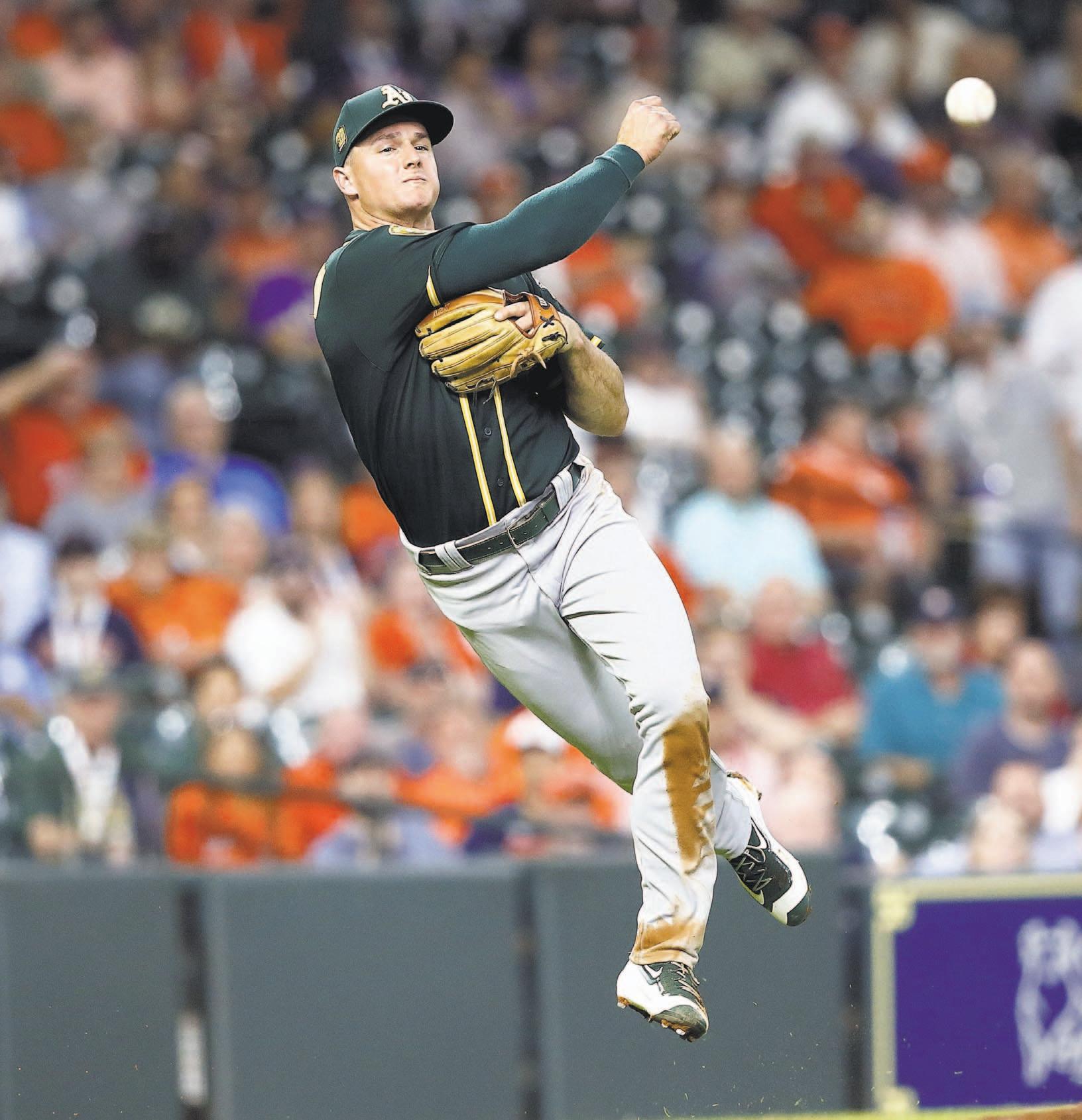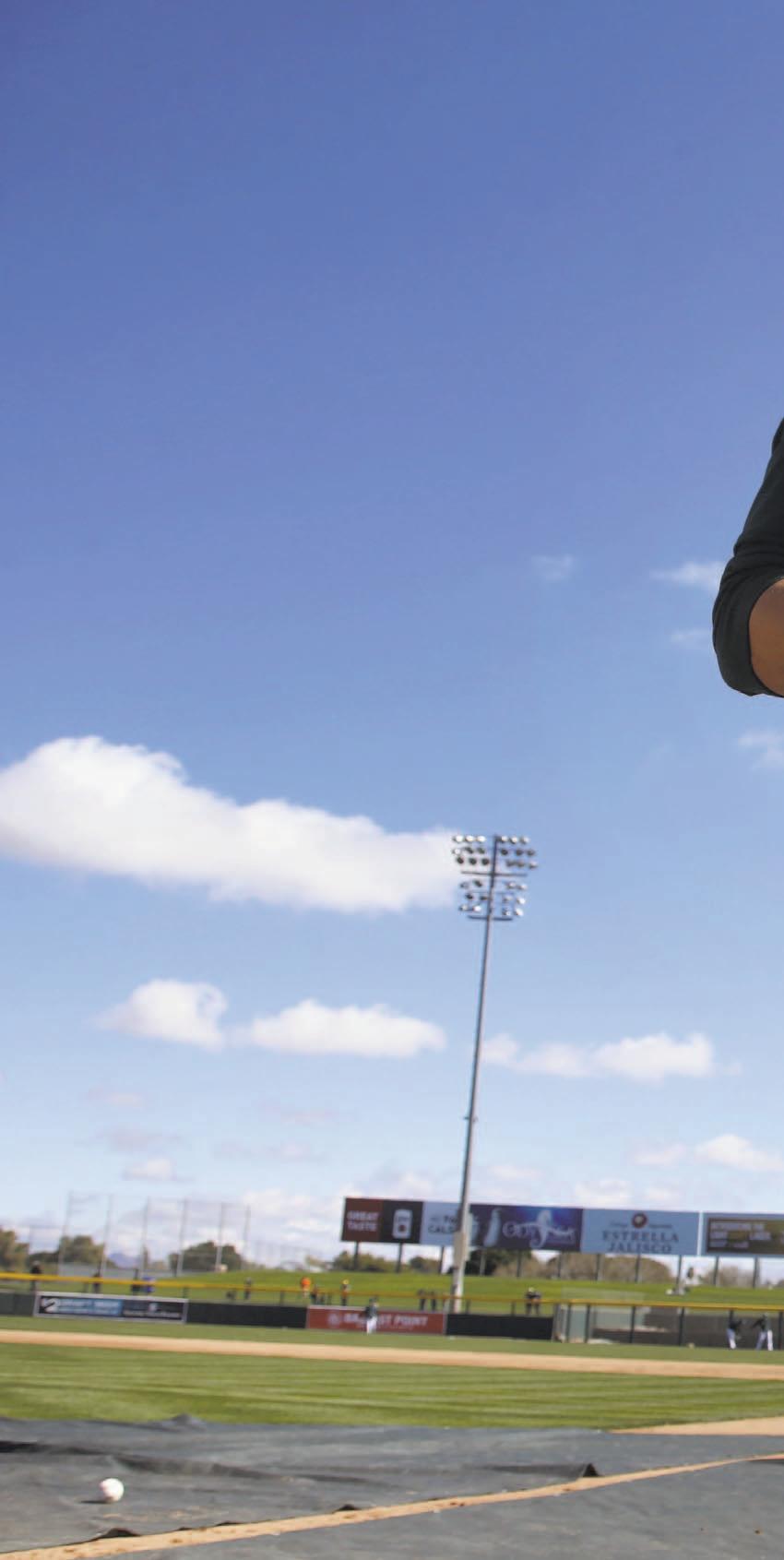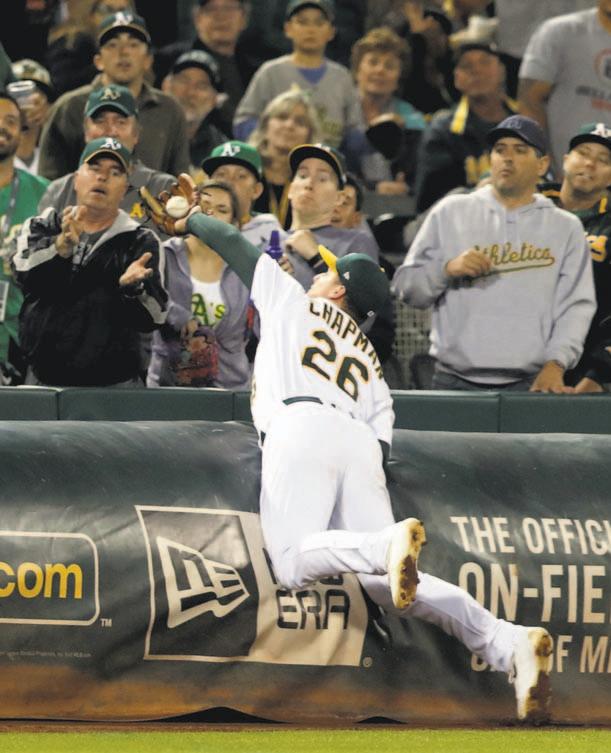
6 minute read
CHASING GREATNESS MATT CHAPMAN IS...
IT TOOK THE A’S PLAYER ONE FULL YEAR OF MAJOR LEAGUE PLAY TO START THE CONVERSATION: COULD WE ALREADY BE LOOKING AT THE BEST DEFENSIVE THIRD BASEMAN OF ALL TIME?
BY MARTIN GALLEGOS
ILLUSTRATION BY TIM MARRS

Who is the greatest of all time? It’s a question that sparks furious debates at sports bars and barbershops around the country.

Jordan or Lebron? Montana or Brady? Ali or Mayweather?
Beyond those highest level arguments lie some of the most interesting. For instance, how about this one for the GOAT of defensive third baseman to walk the earth: Matt Chapman or Mike Schmidt?

Has to seem crazy when, with Schmidt, you’re talking about a 10-time Gold Glove winner — and Chapman just won his first … in his first full major league season.
But check out these numbers. In this new-fangled age of analytics, defensive prowess is determined by just a couple of key stats: Defensive runs saved and UZR.
Chapman’s defensive runs saved for 2018 was 29. The next closest third baseman: Johan Camargo, with seven. Chapman’s UZR was 10.9. The next closest third baseman: Kyle Seager, with 6.6.
The A’s third baseman blew away all other players at his position. Nobody was even close to him, which is why he was awarded not just the Gold Glove at third base, but also the Platinum Glove, which is given to the league’s best defensive player.
In the eight years the Platinum Glove has been a thing, Chapman, 25, was the first player to win the award in his first full big league season.
Unfortunately, true comparisons across eras are all but impossible given the fact UZR, defensive runs saved and Platinum Gloves weren’t things in the eras that spawned the likes of Brooks Robinson, George Brett and Schmidt. But that doesn’t make the bar discussion any less fun.
Clearly one full season cannot make a GOAT, so Chapman has a ways to go. He’ll need to avoid injury. He’ll need to maintain consistency. He’ll need to want to be the greatest.
If his work regimen is any indication, that last point will not be an issue.
Pregame Rituals
Much like Warriors star Stephen Curry has a daily pregame dribbling and shooting routine, Chapman has his own baseball version.
Two hours before gametime, Chapman settles in at the hot corner, taking vicious grounders from A’s manager Bob Melvin in what amounts to an emotional battle royale between the skipper and his GOAT-in-training.
Melvin’s goal: Rifling grounders past the third baseman. On the rare occasion Melvin succeeds, Chap man is none too happy about it.
“He’ll chuck baseballs into the upper deck,” said Matt Williams, A’s third base coach who held down the position with the Giants, Indians and Diamondbacks during a 17-year playing career.
“If Bob hits a ball and he misses, Bob gets one point. If he’s clean, Chappy wins. It’s part of the fun of the game and part of his preparation. He really loves to play defense.”
In the end it’s a win-win just to have a fielder who loves to perfect his craft at this level over what amounts to a long grind of a season. His want and willingness to create actual scenarios he may encounter in a game explains why Chapman makes crazy plays look as routine as possible.
That practice of re-creating potential in-game scenarios is not much different from what Eric Chavez used to do. Chavez is the OG of entertaining fans at the Oakland Coliseum with jaw-dropping third base defense.
Scott Hatteberg had a front-row seat for most of Chavez’s ridiculousness on defense as the A’s first baseman from 2002-2005.
Chavez was the best third baseman Hatteberg had ever seen — until Chapman entered the league.
“It’s just hard to believe someone can be better than Chavez,” Hatteberg said. “The thing they share is that their reflexes and reaction time is spectacular. They make action figure type of plays. They’re just incredibly quicktwitch with quick hands. The range is amazing, you can definitely see it on display in Oakland with all that foul territory.
“I didn’t think anybody could cover as much ground as Chavy. Chapman does the exact same thing. It’s crazy.”
Chavez, now the manager for the Los Angeles Angels Triple-A affiliate, had the chance to get a look at Chapman last season.
It might be hard for a six-time Gold Glove winner to admit someone is better than them, but one area where Chavez immediately concedes is arm strength.
“His feet are extremely good. His hands are extremely good. But I think the arm really separates him,” Chavez said. “Watching him, you could tell he puts himself in position to field the ball and make a good throw over there.”
Hatteberg knows this.
As well as being on the receiving end of throws from Chapman in spring training, the former A’s first baseman can recall scouting Chapman as an amateur at Cal State Fullerton. Not only was Chapman throwing 96 mph as a pitcher in college, but he could fire bullets from third to first from his knees.

“He’s just one of those special gifted guys,” Hatteberg said. “It’s such a pure ball he throws, like a hovercraft. When you catch it, it’s just heavy. There’s just power behind it.
“There’s plenty of guys who throw it hard, but you don’t know where it’s going. He knows where it’s going.”
Chapman And Arenado
So has there ever been a third baseman with the combination of defensive prowess and a cannon of an arm like Chapman? There’s really only one name that comes to mind, and he’s also currently playing and thriving. And, oh, he also shared little league fields and a high school dugout with Chapman in South Orange County.
“His comp is always Nolan Arenado,” Williams said. “I think that’s fair. They are very similar in their aggressiveness and the way they play the game, how they position themselves and what they do in the infield.
“That’s a big comp, but I think it’s deserved. You can’t get any higher than the award he got last year.”
Chapman and Arenado both won Platinum Gloves in their respective leagues last season. But if you ask Arenado which third baseman had a better year, he doesn’t think it’s that close.
“I don’t know too much about how those numbers work. I just know I played a good third base and he played a really, really good third base,” Arenado said. “I know he saves a bunch of runs.”

Arenado’s defensive runs saved was at five last year, which would have been good for second-most in the majors if Chapman did not exist.
Chapman has a legit claim to say he’s a better third baseman than Arenado, but he wants to hear no part of that.
“He thinks I’m better than he is at what?” Chapman laughed. “I want to do what he’s done. I’m definitely motivated to be as good as he is. I do feel that I’m good enough to do some of those things, but you have to prove it before you say you’re better than somebody.”
Much like Chapman and
Chavez, Chapman and Arenado share some similarities in their pregame routine. That’s not by accident.
The two go way back to their days in Lake Forest Little League — and they later joined forces as teammates at El Toro High. Arenado is two years older, so he was the star shortstop while Chapman was his backup. Chap- man did not get much playing time while Arenado was there, but he observed Arenado as much as he could, plotting his rise to stardom once his elder moved up the ladder.
Chapman visualizes game situations before they happen. He can make an extremely difficult play — like a diving into the stands for a fly ball, above left — look like a walk in the park.
He also re-creates potential in-game scenarios during practice, but he may not be able to mimic the post-game pie-in-the-face ritual.
“I would always watch him and try to pick up on some things,” Chapman said. “He might do a little bit more of the jump throw on the backhand and I might do more of the fadeaway throw. I think I’m a little bit lighter on my feet.”
Both visualize game situations before they happen. It’s why they make an extremely difficult play look like a walk in the park.
“He works on all those different scenarios,” Williams said of Chapman. “He gets in the game and when it happens, it’s second nature to him.”
Williams can see Chapman is not satisfied. He’s already great, but that’s not good enough. That’s why Chapman picks his brain along with the rest of the A’s coaches on a daily basis.
There is really only one thing Williams sees left for Chapman to master: patience.
There were times last season when he may have tried to fire a seed over to first when he didn’t exactly need to. It’s common for younger players to take a while to learn this. But once Chapman gets it down, he’ll have gotten one step closer to all-time greatness.
“He wants to be the best, and there’s really only one way to do that. That’s to take every aspect of the game and get as good as you can at it,” Williams said. “He wants to learn and understand the nuances of the game. I still think he can get better.”
So is Chapman in that pantheon of all-time greats? On that Mount Rushmore among the likes of Schmidt, Brett and Robinson? No, not yet — the sample size simply isn’t big enough. But the barstool conversation is well underway.

“Chapman has the chance to go down as one of the best ever,” Hatteberg said. “He has that type of package.”











